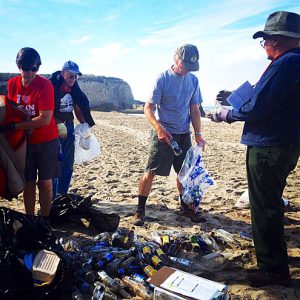Save Our Shores Welcomes Its New Executive Director
“I’m done with sustainability … I’m moving on to restoration and resiliency. It’s not good enough for us to simply sustain the ocean in the condition we’ve put her in.”
After receiving degrees from Harvard and business sustainability certificates from Cambridge, her path toward reducing waste and protecting the environment brought her to San Francisco, a city that O’Dea describes as her most favorite city “in all the world.” You could say that the West Coast is what drove O’Dea’s passion for the ocean and her sustainability knowledge into activism.
From San Francisco, she moved back to the East Coast to become the COO of the Nantucket Conservation Foundation where coastal cleanup, restoration, and conservation were her primary focus. Being able to reintroduce endangered species to restored coastal habitats was some of her most rewarding work. A large part of that process included marine debris abatement, an issue O’Dea worked to reduce while at the Green Blue Institute. She then founded Circular Economy Strategists, a consulting company aimed at helping businesses and governments work together to create more sustainable and economically productive package and product designs.
Q: The San Lorenzo River is seen by some as a relatively untapped resource for restoration, citizen involvement and recreation. Do you consider this a project that SOS could be involved in?
A: The San Lorenzo River is most definitely an important resource for both the city and county of Santa Cruz and it has been and will continue to be a focal point of our work in terms of awareness building and citizen action. In fact, Save Our Shores, this past Saturday (10/24) held “Make A Difference Day,” a cleanup effort along the San Lorenzo from the Laurel Street Bridge to Soquel Bridge. In just 2.5 hours 35 volunteers collected 250 pounds of trash, 50 pounds of recyclable materials, 11 needles and thousands of cigarette butts.
Additionally, Save Our Shores is an active member of the San Lorenzo River Alliance a coalition of concerned organizations. The Alliance was organized by the Coastal Watershed Council and in addition to them and us includes the representative from the city and county, as well as the Arts Council, Resource Conservation District, Chamber of Commerce, Museum of Natural History and the Valley’s Woman’s Club. Its purpose is to conduct water quality monitoring, river cleanups, restoration efforts and community events.

A: I think the City and the Alliance are already working on better management policies and practices. There have been design charettes (an intense period of design or planning activity) to develop options for riverfront reuse that would offer more and better access to celebrate the San Lorenzo as both a natural resource and wildlife habitat as well as a recreation hub. The city can also help increase and expand the cooperation among the Alliance members and ensure required follow-through occurs.
Q: What other coastal areas and estuaries are you concerned about and which will be your priorities?
A: The Pajaro River and Dunes as well as Elkhorn Slough are critically important waterways and watersheds on our radar screen. Both are considered cleanup hotspots where we need to stem the tide of waste and debris flowing onto our shores and potentially into the Monterey Bay National Marine Sanctuary. For the last four years, the Elkhorn Slough has been identified as the single most impacted sight during our Annual Coastal Cleanup. This year SOS staff and the numerous citizen volunteers who came out for the Cleanup collected 2,069 pounds of trash and 119 pounds of recyclable materials in a four-hour period. The Pajaro Dunes are at once one of the most beautiful parts of the Sanctuary and an amazing shorebird habitat, as well as one of the areas most affected by marine debris and where microplastic pollution is most prevalent.
A: That’s an interesting question and I’d actually turn it around. I think East Coast coastal and marine conservation organizations can learn a lot from west coast organizations and particularly Save Our Shores. For example, SOS’s Dockwalker program is a stellar example of extending our shoreline conservation efforts out into the bay. Through this program we provide one-on-one outreach in local harbors to help boaters appropriately discard of used oil, share best clean boating practices, and waste products. I’m not aware of many east coast organizations that have incorporated this important aspect of conservation into their activities. One observation I would make is that because of the climate here in Santa Cruz, people seem to play more and more frequent in and around our marine environment. Because you have more people going to the beach, surfing, boogieboarding, kayaking and boating the wear and tear is more obvious here.